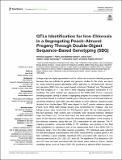Por favor, use este identificador para citar o enlazar a este item:
http://hdl.handle.net/10261/275120COMPARTIR / EXPORTAR:
 SHARE SHARE
 CORE
BASE CORE
BASE
|
|
| Visualizar otros formatos: MARC | Dublin Core | RDF | ORE | MODS | METS | DIDL | DATACITE | |

| Título: | QTLs Identification for Iron Chlorosis in a Segregating Peach–Almond Progeny Through Double-Digest Sequence-Based Genotyping (SBG) |
Autor: | Guajardo, Verónica; Martínez-García, Pedro J. CSIC ORCID ; Solís, Simón; Calleja Satrústegui, Aitziber CSIC ; Saski, Christopher; Moreno Sánchez, María Ángeles CSIC ORCID | Palabras clave: | molecular markers rootstock stone fruits segregating population reference genome pseudomolecule SPAD |
Fecha de publicación: | may-2022 | Editor: | Frontiers Media | Citación: | Guajardo V, Martínez-García PJ, Solís S, Calleja-Satrústegui A, Saski C, Moreno MA. QTLs Identification for Iron Chlorosis in a Segregating Peach–Almond Progeny Through Double-Digest Sequence-Based Genotyping (SBG). Frontiers in Plant Science 13: 872208 (2022) | Resumen: | Linkage maps are highly appreciated tools for cultivar and rootstock breeding programs because they are suitable for genetic and genomic studies. In this study, we report on using sequence-based genotyping (SBG) approach to simultaneously discover and genotype SNPs from two peach-based rootstocks (“Adafuel” and “Flordaguard”) and their progeny (n = 118): from a initial mapping population composed of 131 seedlings. The plant material was developed at the EEAD–CSIC Prunus rootstocks breeding program, aiming to obtain a segregating progeny for a range of characters of agronomical interest to rootstock breeding (iron-chlorosis and root-asphyxia tolerance, nematode resistance, vigor traits, and other effects on scion cultivars). Sequence reads obtained from double-digest SBG were aligned to the P. persica reference genome (Peach v2.0). While eight linkage groups were constructed for “Adafuel,” only four linkage groups were constructed for “Flordaguard,” given the low heterozygosity of this last genotype. High synteny and co-linearity were observed between obtained maps and Peach v2.0. On the other hand, this work aimed to elucidate the genetic basis of leaf chlorosis tolerance using the phenotypic segregation of the progeny to iron-chlorosis tolerance, along with the QTLs responsible for leaf chlorosis. The F1 mapping population, composed initially of 131 seedlings, was growing in four field trials established on calcareous soils at the experimental field of the EEAD-CSIC in Zaragoza, Spain. From the initial mapping population, 131 individuals were selected for their phenotypical characterization with SPAD measurements of plants grown in the field, exhibiting a great variability. Significant QTLs associated with tolerance to iron chlorosis were found in LG1, LG5, LG7, and LG8. The significant QTLs detected in LG5 and LG7 have not been associated with this abiotic stress before in Prunus. Several candidate genes such as Prupe.1G541100, predicted as glutamyl-tRNA reductase 1, Prupe.1G468200, encoding a 2-oxoglutarate (2OG), and Fe(II)-dependent oxygenase superfamily protein or Prupe.1G577000 (ppa011050.m), a NIFU-like protein 2 (NIFU2) were detected. The exact biological function of some of these genes should be verified for the future development of marker-assisted selection for peach iron chlorosis tolerance. | Descripción: | 14 Pags.- 5 Figs.- 2 Tabls. Copyright © 2022 Guajardo, Martínez-García, Solís, Calleja-Satrustegui, Saski and Moreno. This is an open-access article distributed under the terms of the Creative Commons Attribution License (CC BY). | Versión del editor: | https://doi.org/10.3389/fpls.2022.872208 | URI: | http://hdl.handle.net/10261/275120 | DOI: | 10.3389/fpls.2022.872208 | E-ISSN: | 1664-462X |
| Aparece en las colecciones: | (EEAD) Artículos (CEBAS) Artículos |
Ficheros en este ítem:
| Fichero | Descripción | Tamaño | Formato | |
|---|---|---|---|---|
| MorenoMA_FrontPlantSci_2022.pdf | 3,28 MB | Adobe PDF |  Visualizar/Abrir |
CORE Recommender
SCOPUSTM
Citations
2
checked on 13-abr-2024
WEB OF SCIENCETM
Citations
2
checked on 22-feb-2024
Page view(s)
45
checked on 18-abr-2024
Download(s)
47
checked on 18-abr-2024
Google ScholarTM
Check
Altmetric
Altmetric
Este item está licenciado bajo una Licencia Creative Commons

